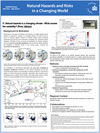PhD-Project I1 by Thomas Moran (FU Berlin): Natural hazards in a changing climate – What causes the variability?
Timescale: Oct. 2015 – Sept. 2019
Supervisors:
Prof. Dr. Uwe Ulbrich, Freie Universität Berlin
Prof. Dr. Henning Rust, Freie Universität Berlin
Background
The frequency of climate-related natural hazards is expected to alter in a changing climate. The effect of anthropogenic climate change depends on the type of hazard and on the region considered. The IPCC tends to focus on common signals (“trends”) in climate models under increasing greenhouse gas forcing. The known fact that the hazard probability varies slowly in a natural way is treated as a problem of detection and attribution. Recent initiatives aimed at establishing decadal predictions (like the German MiKlip initiative) are designed to forecast trends in the coming years, including the occurrence of extremes. An investigation of mechanisms associated with long term variability of European windstorms, based on an ensemble of climate simulations used a simple method to identify anomalous periods.
Objectives and Methods
The goal of this PhD-project was to develop sophisticated methods for the identification and quantification of decadal anomaly periods with respect to the occurrence and intensities of winter wind storms in Central and Southern Europe, discerning them from the anthropogenic climate change. In particular, non-stationary response patterns from ocean temperature anomalies are considered, using decadal climate prediction runs. Sources of variability in the climate system have been studied by using non-stationary extreme value statistics and the fraction of attributable risk approach in order to analyse the effects of drivers of long-term climate variability. Climate simulations with different set-ups were used, e.g., control runs without anthropogenic forcing and ocean-induced decadal variability, transient runs including anthropogenic forcing factors (Millennium run) and finally also decadal forecast experiments. Typical response patterns from specified sources of variability (e. g. greenhouse gases) were used as statistical fingerprints to increase the signal-to-noise ratio in detected and attributed analyses. Non-stationarity was incorporated by using spatio-temporal fingerprints.
Main results
- European windstorms have high variability in their potential impact as well as their frequency
- The majority of Europe’s most devastating windstorms originate around the US East Coast, and a reduced number of them originate in the East Atlantic
- The footprint of these storms is primarily controlled by the strength and position of jet streams, with secondary contributions due to mid-level baroclinicity and moisture availability from the ocean surface
- Upstream land-sea contrasts situated around the US East Coast assist in the formation and magnitude of these storms, with some evidence for the contribution of sea-surface temperature gradients as well
Publications within NatRiskChange:
AGARWAL, A., BOESSENKOOL, B., FISCHER, M., Hahn, I., Köhn, L., LAUDAN, L., MORAN, T., OZTURK, U., Riemer, A., Rözer, V., SIEG, T., VOGEL, K., WENDI, D., Bronstert, A., Thieken, A.H. (2016): Die Sturzflut in Braunsbach, Mai 2016 - Eine Bestandsaufnahme und Ereignisbeschreibung. Taskforce im Rahmen des DFG-Graduiertenkollegs Natural Hazards and Risks in a Changing World, Universität Potsdam (Publisher), 20 pages, urn:nbn:de:kobv:517-opus4-394881
Bronstert, A.,AGARWAL, A., BOESSENKOOL, B., Crisologo, I., FISCHER, M., Heistermann, M., Köhn-Reich, L., López-Tarazón, J.A., MORAN, T., OZTURK, U., Reinhardt-Imjela, C. (2018): Forensic hydro-meteorological analysis of an extreme flash flood: The 2016-05-29 event in Braunsbach, SW Germany, Science of the Total Environment, 630: 977-991. doi.org/10.1016/j.scitotenv.2018.02.241.
Bronstert, A.,AGARWAL, A., BOESSENKOOL, B., FISCHER, M., Heistermann, M., Köhn-Reich, L., MORAN T., WENDI, D. (2017): Die Sturzflut von Braunsbach am 29. Mai 2016 – Entstehung, Ablauf und Schäden eines „Jahrhundertereignisses“. Teil 1: Meteorologische und hydrologische Analyse, Hydrologie & Wasserbewirtschaftung, 61(3): 150-162, https://doi.org/10.5675/HyWa_2017,3_1.
MORAN, T., Ulbrich, U., Rust. H, Grieger, J. (in preparation): Factors affecting the footprint of European winter windstorms.

